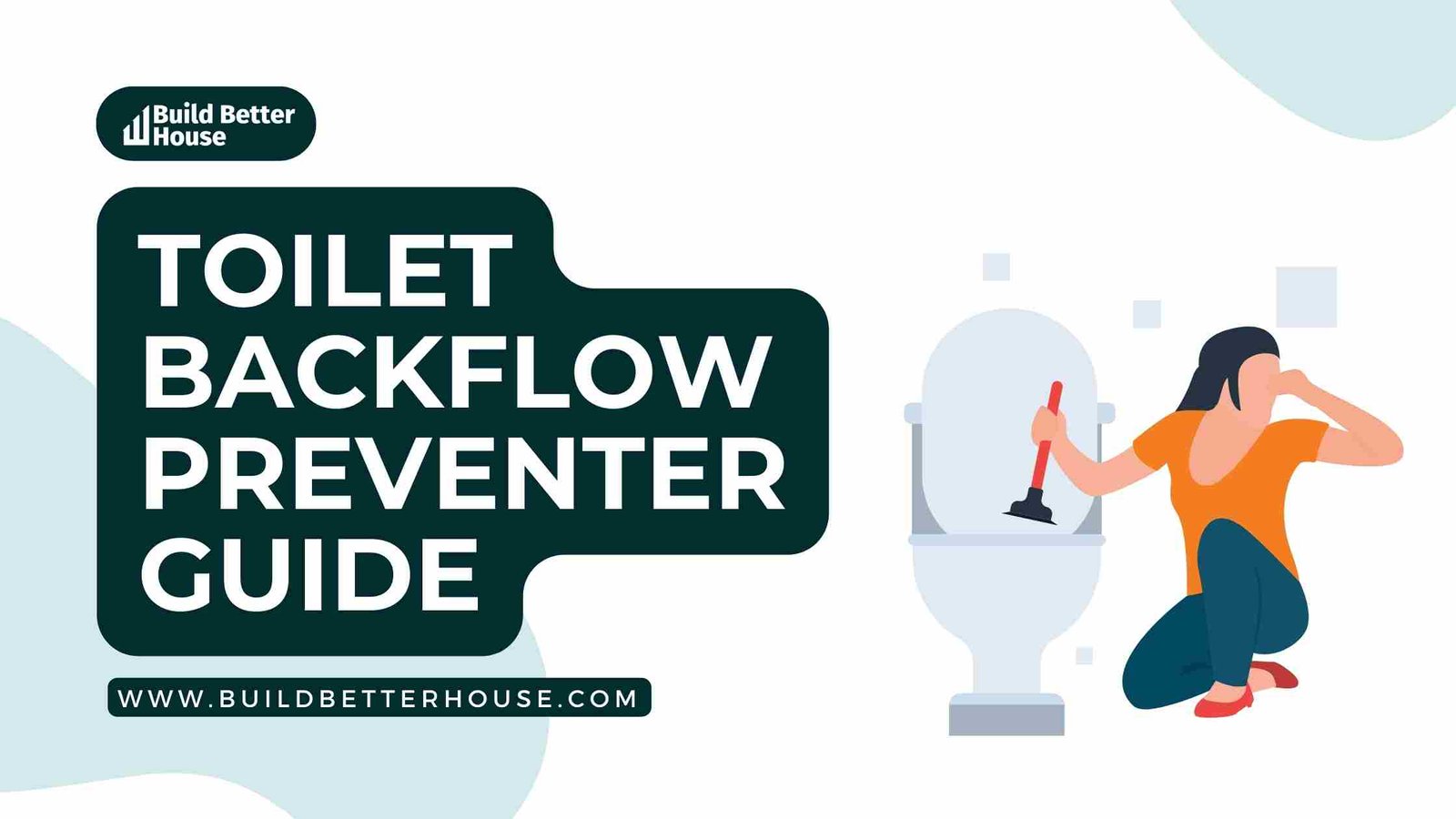Toilet Backflow Preventer Guide: Everything You Need To Know

The toilet is one of the most fundamental components of home plumbing. It is also one of the most important rooms in your home where you can empty waste water outside the toilet. Therefore, as part of your routine for house maintenance, you must be familiar with the toilet backflow prevention guide if you want to keep your home healthy.
Backflow generally causes by issues with your home’s plumbing elements or components. It is common when the water pressure drops below a certain level or other reasons why the water pressure cannot push the waste up and out of your home.
In this blog post, we will explain everything you need to know about the toilet backflow preventer guide and warning signs so that you can make sure prevention measures are in place.
Toilet backflow preventer guide: What is a backflow?
Backflow is when the wastewater from your toilet flows back into the piping system of your house instead of flowing out into the sewage system. Several different problems can cause it. The most common one is a broken or faulty valve that connects the toilet to the city water system.
The flush tank connects to the piping system. If the water is flowing correctly, the pressure can be intense. The flow of water is because the water pressure in your city isn’t strong enough to push the wastewater out of your home. Several reasons include the amount of rain or the neighborhood consuming much water during a house party.
Toilet backflow preventer guide: How does it happen?
Backflow can occur when there is an issue with your toilet’s plumbing; it could be a blocked drain, a problem with the toilet’s internal mechanism, or a faulty backflow prevention device.
Backflow from a toilet occurs because of the design of the internal plumbing. Essentially, there is a pressure differential between the inlet and outlet sides of the toilet.
A tank under the toilet supplies inlet water. The outlet is the waste pipe leading towards the drain. Backflow happens when the differential pressure is too great.
When the pressure on the outlet side of the toilet is too high, it can cause backflow and usually due to a clog in the drain. When liquid can’t pass through the drain, it has to go somewhere.
Since it can’t go through the trap, it’ll find a new path, and that path is back into the toilet bowl. This is especially likely if your toilet uses water from a sink.
Toilet backflow preventer guide: How you can deal?
To prevent backflow, you must ensure that the gaskets, washers, and bolts are well maintained. Here are a few ways to do so:
- Test the flushing system
Ensure that the flushing system works correctly before repairing the broken parts. You can do this by flushing the toilet several times and watching how the water flows. If you notice that the water isn’t flowing as per the norm, you can proceed with repairs.
- Lubricate the flapper
The flapper is the rubber flap that opens up when you flush the toilet. It’s the easiest part to repair and maintain. Dip the flapper into the soap water and rub it with your hand.
- Tighten or replace the bolts, washers, and gaskets
If you’ve checked the flushing system and everything seems fine, you can tighten or replace the bolts, washers, and gaskets.
Familiar places where they found:
- Connection from the toilet to the floor
- Relationship between the tank and the toilet
- Relationship between the flush tank and the overflow pipe
- Drain between the toilet and the floor
Toilet backflow preventer guide: Warning signs
There are a few signs that you have a toilet backflow problem. You can check if the water is flowing out of the toilet by putting a cup underneath it and letting it flow into it.
- If you notice that the water is pooling or flowing back into the toilet, then you may have a backflow problem.
- You might have a backflow issue if you notice the water level in your toilet bowl is rising and can be brought on by a system clog, using excessive toilet paper, or a toilet that won’t drain water.
- If you notice a grayish or yellowish tint in your toilet water, then there is a chance that you have a backflow problem which usually causes by low water pressure due to a clog or other issues with the plumbing in the system.
- If the toilet bowl’s water level goes down, you may have a backflow problem. This happens when the toilet bowl’s water drains back into the plumbing. A clog usually causes this, but a faulty flush valve can also cause it.
By conducting a routine check, these above warning signs will undoubtedly assist you in avoiding future problems which you would handle instantly.
Toilet backflow preventer guide: Prevention device
Installing a one-way backwater valve, such as a backflow preventer, will stop toilet backflow. Since toilet water lines do not carry drinking water, they typically only require a check valve. However, in some regions, a sewer backflow preventer may be necessary if the plumbing nearby impacts the water supply,
A toilet backflow prevention device is appropriately installed and maintained to prevent the accidental contamination of water supplies by backflow.
If a pressure vacuum arises inside a building’s water supply pipes, the pressure is suddenly released and brought back into the pipes, resulting in backflow. This pressure can cause water from an outside source to flow back into a building’s water supply.
Double-check Valve Backflow Prevention Device
A double-check valve backflow prevention device is a type of backflow prevention device designed to prevent backflow and contamination of the potable water supply by preventing reverse flow, backflow, or both.
Check Valve Backflow Prevention Device
The Check valve backflow prevention device is one of the most important devices in your home. It helps prevent backflow, or the backward flow, of water from your toilet. Also, it is a great way to protect your home from water damage.
Pitless Adapter Backflow Prevention Device
In case your toilet backflow prevention device is a pitless adapter, you have a pitless adapter backflow prevention device. A pitless adapter backflow prevention device designed for backflow prevention and contamination of the potable water supply by preventing reverse flow, backflow, or both.
Toilet Backflow Preventer Guide: Things to Repair in the Future
Knowing what to look for will help you avoid purchasing the incorrect goods and save money in the long run. So, here’re a few things to repair in the future:
- Check the flushing system
As mentioned above, the flushing system is the first thing you should check if you experience a backflow or back siphonage. If it breaks, you should repair it as soon as possible.
- Replace the flapper
If you notice that your toilet is running, it may be a sign that the flapper break. You should replace it if it is worn out or has become gross. This is the easiest part of the toilet system to replace and maintain.
- Tighten the bolts and gaskets
As mentioned above, the bolts and gaskets are the most common reason for backflow. You should check the bolts and gaskets periodically and tighten them if necessary. If they aren’t tightened, you may experience a backflow problem.
- Repair the drain in the floor
If you’ve noticed a backflow problem and checked the flushing system and the plumbing, you should also check the drain on the floor. If the drain is broken or clogged, you will experience a backflow.
Maintaining these items and frequently checking on them can quickly address your problem and keep your things running in the long run.
Toilet backflow preventer guide: Things responsible
A backflow preventer keeps water from flowing in the reverse direction, preventing it from draining back into the city sewer system. This is especially true when dealing with properties with private septic tanks or wells. Here are a few reasons that may be to blame and should consider:
- If you notice that you are experiencing a backflow problem, you should check the bolts and gaskets.
- If broken, rusting, or missing, you should replace them with new ones.
- Suppose you see the water level in your toilet bowl rising. If a greyish or yellowish tinge in your toilet water, the water level in your toilet bowl falls, or water pooling or flows back into the toilet, you may have a backflow problem.
The most common gaskets that may be responsible for your toilet’s backflow problem are the ones connecting the flush tank to the toilet and the ones relating the toilet to the floor.
Conclusion
Backflow is when the wastewater from your toilet flows back into the piping system of your house instead of flowing out into the sewage system. It can cause several problems, including a broken or faulty valve connecting the toilet to the city water system or the flush tank’s connection to the piping system.
The most common gaskets that may be responsible for your toilet’s backflow problem are the ones connecting the flush tank to the toilet and the ones relating the toilet to the floor.
Read more:
Sump Pump Running No Rain – How To Fix This?
No sump pump in the basement? Don’t worry!
7 Best Hot Water Recirculating Pumps in 2023: Tested & Compared
Ideal French Drain Gravel Size For Your Yard: Everything You Need To Know
How Much Does Backflow Testing Cost? The Ultimate Guide






